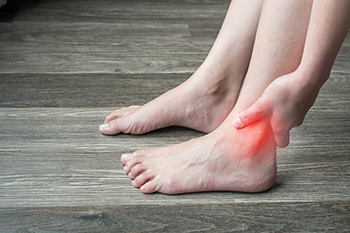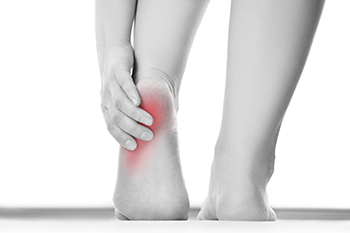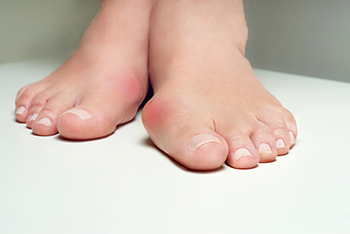September 2024
Do Your Child's Feet Hurt?
Symptoms and Causes of Ankle Pain

Ankle pain can also result in swelling, and stiffness. While the pain may be sharp, dull, or throbbing, it often intensifies with movement or pressure. Swelling surrounding the ankle can indicate inflammation or injury, leading to visible puffiness and discomfort. Stiffness in the joint can limit mobility, making it difficult to flex or extend the ankle fully. Common causes of ankle pain include sprains, strains, and fractures from trauma or overuse. Conditions like arthritis or tendinitis can also contribute to chronic pain and swelling. A proper diagnosis by a podiatrist is vital to determine the underlying cause and guide appropriate treatment. If you have ankle pain, it is suggested that you contact a podiatrist to determine the cause and offer treatment solutions.
Ankle pain can be caused by a number of problems and may be potentially serious. If you have ankle pain, consult with Dr. Thomas Madden from Advanced Foot Care Center. Our doctor will assess your condition and provide you with quality foot and ankle treatment.
Ankle pain is any condition that causes pain in the ankle. Due to the fact that the ankle consists of tendons, muscles, bones, and ligaments, ankle pain can come from a number of different conditions.
Causes
The most common causes of ankle pain include:
- Types of arthritis (rheumatoid, osteoarthritis, and gout)
- Ankle sprains
- Broken ankles
- Achilles tendonitis
- Achilles tendon rupture
- Stress fractures
- Bursitis
- Tarsal tunnel syndrome
- Plantar fasciitis
Symptoms
Symptoms of ankle injury vary based upon the condition. Pain may include general pain and discomfort, swelling, aching, redness, bruising, burning or stabbing sensations, and/or loss of sensation.
Diagnosis
Due to the wide variety of potential causes of ankle pain, podiatrists will utilize a number of different methods to properly diagnose ankle pain. This can include asking for personal and family medical histories and of any recent injuries. Further diagnosis may include sensation tests, a physical examination, and potentially x-rays or other imaging tests.
Treatment
Just as the range of causes varies widely, so do treatments. Some more common treatments are rest, ice packs, keeping pressure off the foot, orthotics and braces, medication for inflammation and pain, and surgery.
If you have any questions, please feel free to contact our office located in Killeen, TX . We offer the newest diagnostic and treatment technologies for all your foot care needs.
What Is Hammertoe?

Hammertoe is a condition where one or more toes bend abnormally at the middle joint, resembling a hammer. This deformity often causes the affected toe to curl downward rather than lie flat. Symptoms include pain and discomfort, especially when wearing tight or ill-fitting shoes. Hammertoes also cause the formation of corns or calluses on the toe or the top of the joint as it rubs against the shoe. Hammertoe typically results from muscle imbalances or imbalances in the tendons that control toe movement. Contributing factors include wearing high heels or shoes with inadequate room for toes, genetic predisposition, and conditions such as arthritis or diabetes. If you notice signs of hammertoe, it is suggested that you promptly visit a podiatrist who can offer effective treatment solutions.
Hammertoes can be a painful condition to live with. For more information, contact Dr. Thomas Madden of Advanced Foot Care Center. Our doctor will answer any of your foot- and ankle-related questions.
Hammertoe
Hammertoe is a foot deformity that occurs due to an imbalance in the muscles, tendons, or ligaments that normally hold the toe straight. It can be caused by the type of shoes you wear, your foot structure, trauma, and certain disease processes.
Symptoms
- Painful and/or difficult toe movement
- Swelling
- Joint stiffness
- Calluses/Corns
- Physical deformity
Risk Factors
- Age – The risk of hammertoe increases with age
- Sex – Women are more likely to have hammertoe compared to men
- Toe Length – You are more likely to develop hammertoe if your second toe is longer than your big toe
- Certain Diseases – Arthritis and diabetes may make you more likely to develop hammertoe
Treatment
If you have hammertoe, you should change into a more comfortable shoe that provides enough room for your toes. Exercises such as picking up marbles may strengthen and stretch your toe muscles. Nevertheless, it is important to seek assistance from a podiatrist in order to determine the severity of your hammertoe and see which treatment option will work best for you.
If you have any questions, please feel free to contact our office located in Killeen, TX . We offer the newest diagnostic and treatment technologies for all your foot care needs.
Causes of Heel Pain

Heel pain can arise from a variety of causes, most often related to overuse, wearing improper footwear, or structural issues in the foot. Plantar fasciitis, which involves inflammation of the thick band of tissue that connects the heel bone to the toes, is the most frequent cause. Other possible causes of heel pain include Achilles tendonitis, stress fractures, or nerve entrapment like tarsal tunnel syndrome. Systemic conditions, such as arthritis or diabetes, can also contribute to heel pain, especially in older adults or those who are overweight. Regardless of the underlying cause, a podiatrist can diagnose the condition through a physical examination and imaging tests. Treatment options may include practicing specific exercises, custom orthotics, or in some cases surgery. If you have persistent or worsening heel pain, it is suggested that you schedule an appointment with a podiatrist to determine the cause and recommend appropriate treatment.
Many people suffer from bouts of heel pain. For more information, contact Dr. Thomas Madden of Advanced Foot Care Center. Our doctor can provide the care you need to keep you pain-free and on your feet.
Causes of Heel Pain
Heel pain is often associated with plantar fasciitis. The plantar fascia is a band of tissues that extends along the bottom of the foot. A rip or tear in this ligament can cause inflammation of the tissue.
Achilles tendonitis is another cause of heel pain. Inflammation of the Achilles tendon will cause pain from fractures and muscle tearing. Lack of flexibility is also another symptom.
Heel spurs are another cause of pain. When the tissues of the plantar fascia undergo a great deal of stress, it can lead to ligament separation from the heel bone, causing heel spurs.
Why Might Heel Pain Occur?
- Wearing ill-fitting shoes
- Wearing non-supportive shoes
- Weight change
- Excessive running
Treatments
Heel pain should be treated as soon as possible for immediate results. Keeping your feet in a stress-free environment will help. If you suffer from Achilles tendonitis or plantar fasciitis, applying ice will reduce the swelling. Stretching before an exercise like running will help the muscles. Using all these tips will help make heel pain a condition of the past.
If you have any questions please contact our office located in Killeen, TX . We offer the newest diagnostic and treatment technologies for all your foot and ankle needs.
Bunion Symptoms and Treatment

Bunions are bony bumps that form at the base of the big toe, often caused by a misalignment of the toe joint. This condition leads to the big toe angling toward the other toes, creating an uncomfortable and noticeable protrusion. Common symptoms include pain, swelling, and difficulty wearing certain shoes. Bunions can result from genetic factors, excessive foot stress, or wearing ill-fitting shoes. Treatment for bunions focuses on managing pain and slowing progression. Initially, this involves wearing properly fitting shoes with a wide toe box and using orthotic inserts to reduce pressure. Taking anti-inflammatory medications can help with discomfort. In more severe cases, where conservative measures fail, surgical options may be considered to realign the toe and correct the deformity. If you're experiencing symptoms of a bunion or need advice on managing foot discomfort, it is suggested you make an appointment with a podiatrist who can provide expert care and tailor treatment to your specific needs.
If you are suffering from bunions, contact Dr. Thomas Madden of Advanced Foot Care Center. Our doctor can provide the care you need to keep you pain-free and on your feet.
What Is a Bunion?
A bunion is formed of swollen tissue or an enlargement of boney growth, usually located at the base joint of the toe that connects to the foot. The swelling occurs due to the bones in the big toe shifting inward, which impacts the other toes of the foot. This causes the area around the base of the big toe to become inflamed and painful.
Why Do Bunions Form?
Genetics – Susceptibility to bunions are often hereditary
Stress on the feet – Poorly fitted and uncomfortable footwear that places stress on feet, such as heels, can worsen existing bunions
How Are Bunions Diagnosed?
Doctors often perform two tests – blood tests and x-rays – when trying to diagnose bunions, especially in the early stages of development. Blood tests help determine if the foot pain is being caused by something else, such as arthritis, while x-rays provide a clear picture of your bone structure to your doctor.
How Are Bunions Treated?
- Refrain from wearing heels or similar shoes that cause discomfort
- Select wider shoes that can provide more comfort and reduce pain
- Anti-inflammatory and pain management drugs
- Orthotics or foot inserts
- Surgery
If you have any questions, please feel free to contact our office located in Killeen, TX . We offer the newest diagnostic and treatment technologies for all your foot care needs.





